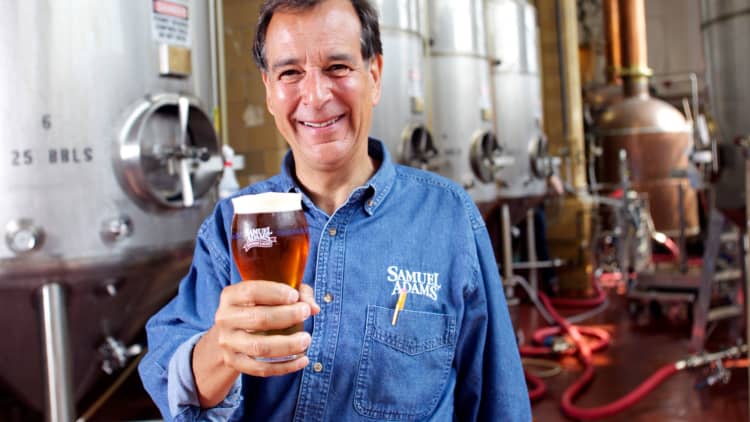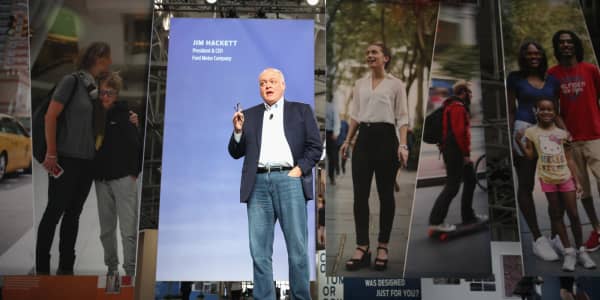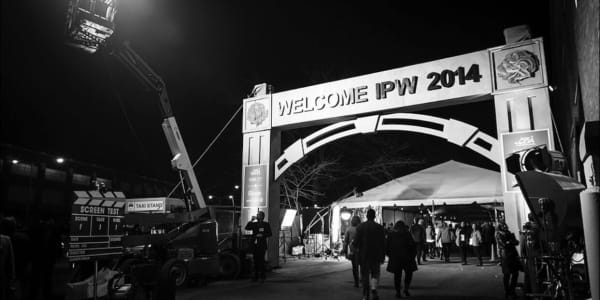Long before hipsters, long before foodies, long before farmer's markets that act as auditions for Whole Foods, there was "craft."
The term, which today can describe everything from cocktails to pizza, originally was applied to beer. Craft brewing traditionally involves small, independent producers who use a mix of traditional and innovative processes and ingredients to create distinctive, high-quality quaffs.
But the characteristics of craft can also be applied to a company's culture, said Jim Koch, founder and CEO of The Boston Beer Company and author of the new book "Quench Your Own Thirst: Business Lessons Learned Over a Beer or Two."
In the three decades it's taken him to build a company with a market cap of more than $2 billion and capture 1 percent of the U.S. beer market, Koch has been building an internal "craft culture" that mirrors processes for making the company's signature Samuel Adams Lager. Last year the company posted annual revenues of $960 million.
Koch shared some of the similarities behind his approaches to product and to people.
More from iCONIC:
Great American craft beer bars of 2016
How millennials are building the next iconic pizza chain
The simple tricks of a CEO who grew sales from zero to $2 billion
1. Innovate your way to success
Innovation is a craft point of pride. Boston Beer routinely experiments with unexpected ingredients, such as powdered plums and anise. It also reinvents processes. Almost 25 years ago Boston Beer became the first brewer to age beer in spirit barrels, a now standard practice that, Koch said, "everyone thought was illegal because you couldn't commingle different types of alcohol."
2. Hire "out-of-the-box" thinkers
Rebelling against his consulting background, Koch prefers "messy résumés" to what he calls "check the box" hiring. People who add the most value typically have gaps in their experience," he said. "They veered off track. They did things that might make you ask, 'Why did you do that?'"
Such employees, Koch argued, keep the culture percolating with energy and curiosity. "You can't have a whole company of them," Koch said. "But without them all you'll ever do is standard things."
Koch's very first hiring decision was unorthodox. Looking for a partner to start Boston Beer, he surveyed his Ivy-educated colleagues at Boston Consulting Group and chose … his secretary. Rhonda Kallman had no college degree, "but she was capable, resourceful, committed, energetic, driven, smart and great with people," said Koch. She was also fun. And she knew her way around a bar.
For 15 years Kallman played an integral part in Boston Beer's success. She effectively launched the company's sales efforts by identifying 100 bars that should be serving Sam Adams and then, along with Koch, doggedly pursuing them. And while Koch focused on operations and brewing, it was Kallman who built Boston Beer's sales team.
3. Understand the customer experience
At the core of craft, Koch said, is an intense focus on the customer experience. For example, about 10 years ago he realized beer lovers were ill-served by traditional pint glasses, which "dissipated the aroma, got warm too quickly, and did not allow the release of hop components and fermentation esters."
In response, he enlisted three PhD's in sensory science to help create the optimal beer glass. Among its features: an angled lip that delivers beer to the right points on the palate, a narrower glass base and thinner walls to reduce heat from the drinker's hand, and a laser-etched site on the bottom that creates bubbles for constant aroma release.
4. Create a craft culture
Koch believes that in a craft culture, employees must see themselves as craftspeople, which is not easy to do if your job involves answering phones or sweeping floors. So 15 years ago the company began distributing home-brew kits to employees and encouraging them to get creative in their kitchens. Every year hundreds of them submit the results of their experiments for judging and a winner is chosen. Then the best recipe is produced and distributed around the country in bottles with the winner's name and face on it.
"We have had winners from everywhere in the company: accountants, salespeople, maintenance people," said Koch. "Rarely have actual brewers won."
The contest lets everyone "recognize within themselves the spirit of a brewer and become part of the craft," Koch said. The commercial rollout is testament to leadership's trust and pride in its workforce.

5. Stick to trusted fundamentals
Craft brewers adhere to tradition. "You understand why people have done things a certain way for 100 years," said Koch. So in the early stages of product development, Koch — a fifth-generation brewmaster — set out to find the classic hops described in his family's recipe, even though he wasn't sure they were still being grown. That fidelity to the fundamentals paid off almost immediately when Samuel Adams was named Best Beer in America at the 1985 Great American Beer Festival.
The company has continued to win awards at competitions and festivals — some 500 this year alone. In 2014 Koch was presented with the Bavarian Order of Beer, the first non-German honoree in the award's 35-year history.
Ultimately, a craft culture treats people as the foundation of success, said Koch. People are always the answer. He recalls a period of stagnation that set in around 1996, when a board member with a big-company background observed that head count was too high and advised Koch to start cutting jobs.
"My response was that the people are not the problem. They are going to be the solution," he said. "They are going to find savings and efficiencies and unproductive spending. And we will get costs and revenues in balance."
Sure enough, employees collectively devised ways to tighten operations, proving that "human creativity and teamwork can trump financial resources," said Koch. For example, by fitting additional pallets of beer on trucks, filling excess shipment space with coasters and creating more efficient plans for sales calls. Growth came back slowly, but it did come back. Boston Beer's more rapid acceleration began in 2004, when revenues increased 22 percent.
— By Leigh Buchanan, special to CNBC.com




